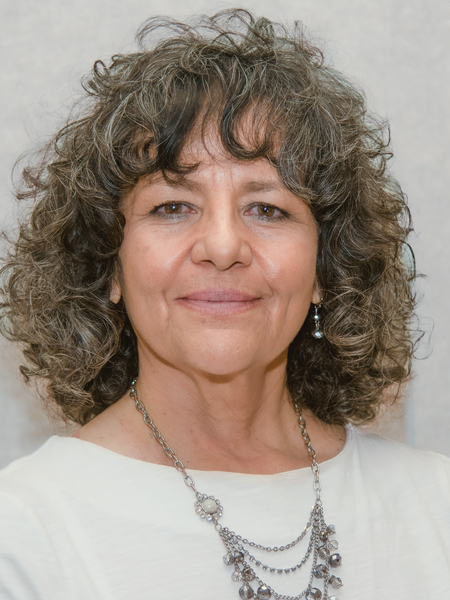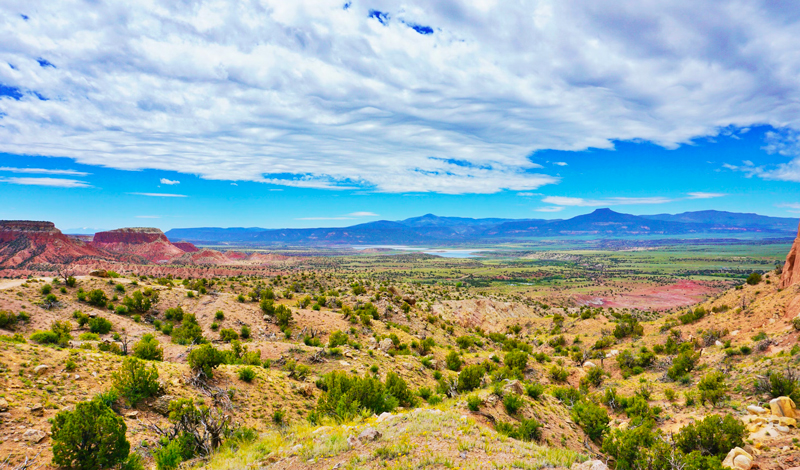Living Buddhism met with Tina Cordova of the Tularosa Basin Downwinders Consortium, which advocates for medical care and compensation for people and their families affected by nuclear bomb testing in New Mexico. The “downwinders,” who lived downwind of the testing sites, together with their families and successive generations, have experienced high rates of cancer due to radiation exposure. We spoke with Ms. Cordova about the humanitarian consequences of nuclear weapons.

Living Buddhism: We understand you were born and raised in Tularosa, a town some 45 miles, as the crow flies, from the Trinity test site, where the first nuclear bomb was detonated on July 16, 1945. What memories were passed down?
Tina Cordova: My grandmother remembers the blast waking them up. Early, 5:30 in the morning.
Today in Albuquerque, it’s 105 degrees. Unusual for us, but in Tularosa in July, not unusual. Everyone left their doors and windows open. She remembers ash falling from the sky that fell for days after.
They experienced the flash, brighter than the day. Broken windows, cracked walls, knocked out of bed. Enormous, grand, more than anyone has found words to describe. The resounding theme: the end of the world.
A gentleman I got to know well, he was a boy, driving with his mother and brother, at the time of the blast. His mother pulled the car over, and they stared at the fireball coming up out of the sky. They watched the fireball ascending. Thought he was going to see God comin’ out of the cloud. His eyesight never fully recovered.
Few people had radio, none had a television or telephone, so information was sparse. A journalist with the Manhattan Project wrote a total lie: “An ammunition dump on Alamogordo Bombing Range, now White Sands Missile Range, had exploded. No harm done, no loss of life.”
What should people understand about the detonation of this particular bomb, set off in the desert in 1945?
Cordova: At the time, local people were told [the Manhattan Project] didn’t know what they were doing; that’s not true. They even detonated an earlier bomb to mimic fallout and laced it with plutonium to track it. So they knew the bomb would create fallout.
The bomb was much larger and more powerful than they expected. Also, they didn’t know exactly how much plutonium would be necessary for fission to take place. The bomb was packed with 10 pounds of weapons-grade plutonium going into the stratosphere. What goes up has to come back down. Radioactive ash, all over: fence posts, the land, the people.
You’ve noted the lifestyles of those living near the epicenter of the Trinity blast. What did the blast mean for the people living there?
Cordova: In 1945, there was no running water in most small towns in New Mexico. People relied heavily on rain, filling up cisterns, containment systems where we held water. Lakes, rivers, streams, ditches all were contaminated.
It also contaminated the earth. Cows, sheep, pigs, goats, chickens. We hunted for birds to supplement our diets. Those were contaminated. We were maximally exposed.
Could you talk about your family’s history of cancer?
Cordova: I’m the fourth generation to have cancer since 1945. Two great-grandfathers were living in Tularosa, and 10 years after the bomb they were told they had stomach cancer. Both of them. They were sent to doctors in El Paso who diagnosed them, gave them morphine and sent them home to die.
We had never heard the word cancer in our communities before the bomb. In addition, my mother’s mother and father’s mother had cancer. Then my father got cancer. He never smoked or chewed tobacco, but it was found first at the base of his tongue. And then it was found in his prostate.
The doctor treating my father at the University of New Mexico cancer center was treating seven other people from Tularosa for the same thing.
You mentioned you also developed cancer.
Cordova: When I was 39, I developed thyroid cancer. I was asked when I was exposed to radiation, if I worked in a lab with radioactive isotopes or if I ever had a lot of X-rays. No, no and no.
My family—everyone in New Mexico is a downwinder of something. We don’t ask if we’ll get cancer but when it will be our turn.
Even my 23-year-old niece was diagnosed while studying in California. She had no symptoms but went in for something else. The doctor happened to feel her neck. “You’ve a tumor in your thyroid; need to get it checked,” he said.
What prompted you to co-found Tularosa Downwinders Consortium 18 years ago?
Cordova: I always had this gut feeling about the reason why people were so sick from a young age. At some point, I’d lost track of how many of us had cancer. I wanted to start an organization to support the atomic bomb test victims.
At first, I was naïve, thinking once we brought this issue to the government’s attention, they’d take care of it right away. We’re now 18 years in and still working on it. Our focus has been lobbying for the Radiation Exposure Compensation Act (RECA).[1] Aside from lobbying, we also spend time on educating and working with members of Congress to address this injustice.
What are the particularities of New Mexico that pose stumbling blocks to receiving care?
Cordova: In New Mexico, because much of our state is rural, there’s limited access to health care. People can’t be diagnosed with cancer or treated in Tularosa. And because some people have unusual, advanced cancers, they have to travel out of state to address them, like to Phoenix, Houston or El Paso.
This situation has had a huge economic impact. When sick, many can’t work and must rely on Medicaid. This has had a very negative economic impact on our state. I say a lot of the time: You may not identify as a downwinder, but you’re paying for it; we’re all paying for it.
We’re told on a regular basis that it will cost too much to add us to RECA, which adds insult to injury. We spend $50 billion every year just maintaining our nuclear weapons arsenal,[2] while RECA has costed just $2.9 billion over 33 years. For someone to say it’s gonna cost too much, my response is, Ha… no.
Josei Toda, the second president of our lay Buddhist movement, the Soka Gakkai, said to young people, “A new age will be created by the passion and power of youth.”[3] What do you find in your own discussions with young people?
Cordova: I’m so grateful when I get to speak to the youth. Most young people embrace the idea of peace, nonproliferation and protecting people who’ve been affected.
Youth view this issue through a different lens. They see nothing but waste associated with these buildups and that money should be better spent. Young people are able to grasp that idea without the conflict of having lived through the Cold War.
What would you like to say to these clear-eyed young people?
Cordova: You’re our future. Though associated with our past, you’re associated with our future as well. We are counting on young people to get involved in these issues and make a difference.
From the September 2023 Living Buddhism
References
- The Radiation Exposure Compensation Act (RECA) established an administrative program for claims relating to atmospheric nuclear testing and uranium industry employment. The Act delegated authority to the Attorney General to establish procedures and make determinations regarding whether claims satisfy statutory eligibility criteria. ↩︎
- https://armscontrolcenter.org/issues/security-spending/nuclear-weapons-spending <accessed on July 20, 2023>. ↩︎
- November 12, 2021, World Tribune, pp. 2–3. ↩︎
You are reading {{ meterCount }} of {{ meterMax }} free premium articles

